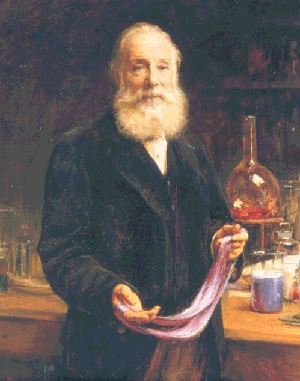Perkin was born in
London. He was the youngest son of a builder.
He started to attend
the City of London School, where he was under the tuition of Thomas Hall.
Perkin's father allowed
Perkin to study chemistry at the Royal College of Chemistry in London.
Even though his father had wanted him to follow a career in architecture.
Perkin was made Johann
Hofmann's assistant.
Hofmann mentioned to Perkin how desirable it was to produce Quinine by a synthetic method. So during the Easter break of that year he set up a makeshift laboratory at home and start experimenting at synthesizing quinine.
 Perkin
idea of how to synthesize quinine, was to change allyltoluidine, which
is an amine produced from coal tar, into quinine by oxidative condensation.
On his first attempt he used the sulphate salt of allyltoluidine and potassium
dichromate. From this reaction he obtained a reddish brown sludge. Then
on his second attempt he used the salt of aniline, after oxidative condensation,
Perkin had obtained a black sludge. Often in the nineteenth century organic
chemists would discard any dark masses that were obtained, as they were
only generally interested in clear crystalline materials.
Perkin
idea of how to synthesize quinine, was to change allyltoluidine, which
is an amine produced from coal tar, into quinine by oxidative condensation.
On his first attempt he used the sulphate salt of allyltoluidine and potassium
dichromate. From this reaction he obtained a reddish brown sludge. Then
on his second attempt he used the salt of aniline, after oxidative condensation,
Perkin had obtained a black sludge. Often in the nineteenth century organic
chemists would discard any dark masses that were obtained, as they were
only generally interested in clear crystalline materials.
Perkin started to inspect this black sludge that he had created and he found that when he dissolved this black precipitated in ethanol in gave a rich purple colour. Perkin soon realised that he had synthesized a solution that had the properties of a dye, he called this product mauvine. He quickly patented the manufacturing process and then left the Royal College.
Perkin hadn't managed
to synthesize quinine but he was disappointed with the results of his
experiment, as the mauvine was to make him his fortune.
Using his father's
savings, Perkins opened the factory Perkins & Sons that was built
at Greenford Green near Harrow. Despite numerous of initial problems such
as aniline not being readily available and therefore it had to be synthesized
at the factory from benzene. But by the end of 1857 the factory was mass-producing
mauvine, the first synthetic dye.